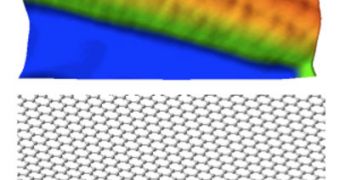A collaboration of physics experts in the United States announces that it just finished conducting the first measurements of edge states on well-ordered nanoribbons. These structures, made up of graphene, have been hypothesized since the 1990s, but they were only made a reality recently.
Graphene itself was first obtained in 2005. The material is a single-atom-thick carbon compound that has only two dimensions and is the strongest material ever produced. It can be used for a wide array of applications, and its creators were awarded the 2010 Nobel Prize in Physics for their work.
The compound is tougher than diamond, but it looks like a honeycomb. This hexagonal structure allows it to have some amazing chemical and physical properties, but also to become the basis of even more advanced materials, such as for example nanoribbons and carbon nanotubes (CNT).
More than 20 years ago, experts predicted that a number of interesting effects would take place at the edge of graphene nanoribbons. Until now, there was no way for those predictions to be tested, but recent advancements made it all possible.
The work was conducted by a collaboration of experts from the US Department of Energy’s (DOE) Lawrence Berkeley National Laboratory (Berkeley Lab), the University of California in Berkeley (UCB), the Stanford University, and other research institutions.
The team carried out the first precise measurements of the “edge states” of well-ordered nanoribbons.
“Until now no one has been able to test theoretical predictions regarding nanoribbon edge-states, because no one could figure out how to see the atomic-scale structure at the edge of a well-ordered graphene nanoribbon and how, at the same time, to measure its electronic properties within nanometers of the edge,” explains Michael Crommie.
“We were able to achieve this by studying specially made nanoribbons with a scanning tunneling microscope,” adds the expert, who holds joint appointments at the Berkeley Lab Materials Sciences Division (MSD) and the UCB Physics Division. He was also the leader of the research effort.
According to the group, the measurements confirmed the theoretical predictions in all aspects. This means that it may soon become possible to create energy-efficient nanoscale devices from graphene-nanoribbon switches and spin-valves to detectors.
“Making flakes and sheets of graphene has become commonplace, but until now, nanoribbons produced by different techniques have exhibited, at best, a high degree of inhomogeneity,” the researcher explains.
Details of the new investigation were published in the May 8 issue of the esteemed scientific journal Nature Physics.

 14 DAY TRIAL //
14 DAY TRIAL //